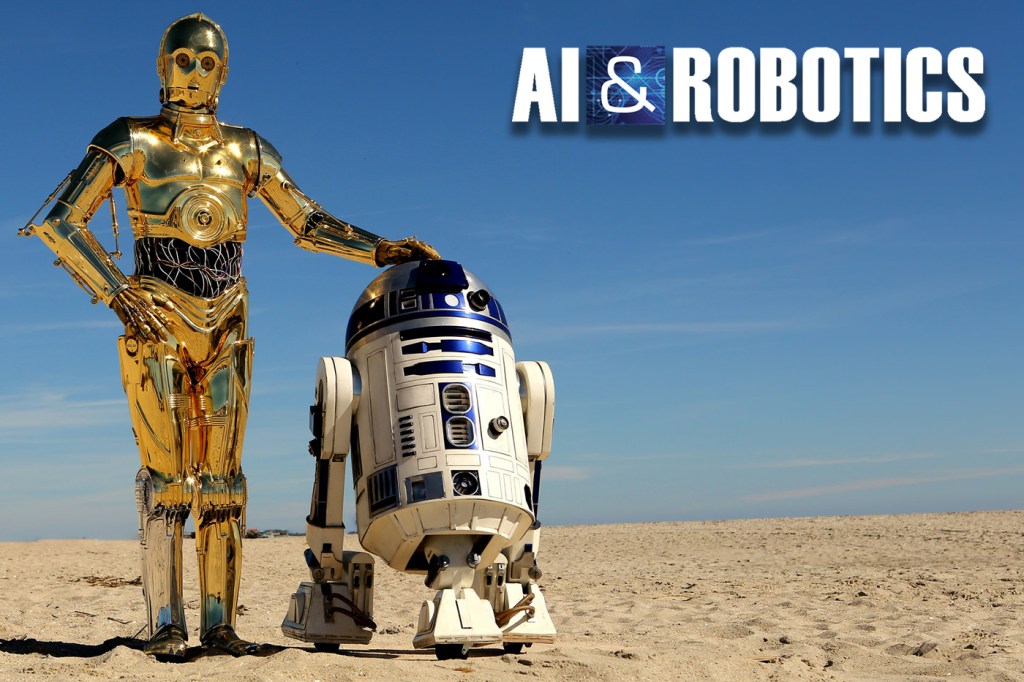Robotics experts find inspiration from Star Wars universe

When Northeastern’s Rob Platt worked as a robotics engineer at NASA’s Johnson Space Center once upon a time, he served as the autonomy and controls lead for the Robonaut 2, a humanoid robot that is now deployed on the International Space Station. The goal, Platt said, was to design a robot that could help humans work in and explore space—in particular, perform repairs and other jobs deemed too dangerous for astronauts.
To explain his work, Platt used an analogy from a galaxy far, far away.
“In Star Wars, R2-D2 is strapped to the back of Luke Skywalker’s X-Wing fighter, and his job is to fix things when the spacecraft gets shot,” said Platt, assistant professor in the College of Computer and Information Science. “It’s kind of the same way with Robonaut, to make those types of repairs. That’s the way I used to explain Robonaut’s role in space. If something breaks on the outside of ISS, Robonaut could potentially go out and fix it.”
Platt is referring to the iconic, resourceful astromech droid from the Star Wars universe. With the latest Star Wars film, The Last Jedi, opening in theaters this week, we asked two Northeastern faculty members with expertise in robotics—Platt and Taskin Padir—to view their work through that galaxy’s lens.
‘Hollywood is usually 50 to 100 years ahead of the reality’
Padir, associate professor of electrical and computer engineering, is leading a team of Northeastern researchers that is performing advanced research on another humanoid robot prototype, this one called Valkyrie, for NASA. He’s a casual fan of Star Wars, and enjoys watching the films. When it comes to Star Wars, like most sci-fi, “Hollywood is usually 50 to 100 years ahead of the reality,” he said.
That goes for R2-D2 and his longtime space buddy, C-3P0—a droid that is more human-like than his smaller counterpart. In the films, “Artoo” is equipped with gadgets such as a holoprojector, data probe, utility arm, and fire extinguisher, to name a few. He can also perform under pressure—having fixed the Millennium Falcon’s hyperdrive in seconds, as the dreaded Empire closed in.
“R2-D2 is a doer, and I think in our research we always want to make things work with robots,” Padir said. C-3P0, for its part, is fluent in millions of forms of communication. Padir noted that this fall, Google unveiled headphones with technology to translate some 40 languages in real time.
“Certain traits,” Padir said of the Star Wars droids, “are definitely within reach.”
The future of robotics
Platt, for his part, is “down with Star Wars,” having seen the films including last year’s Rogue One. His lab focuses on robotic manipulation—this is, building robots that can use their limbs to perform various tasks in real-world environments, particularly in the home. His goal is to build key enabling technologies for a real-life Rosie the robot, like in The Jetsons.
“It’s interesting to think about what the future of robotics might look like,” Platt said. He noted that big challenges remain in developing robots that can handle “unstructured environments”—notably the need to improve their perception and sensing capabilities.
Platt also thinks about the future of robots from a different perspective. He said the droid characters in Star Wars “look and act a lot like people”—particularly some of the robotic characters that have appeared in the newer Star Wars films. K-2S0, a reprogrammed security droid in Rouge One, provides comic relief, while the cute rolling droid BB-8 from The Force Awakens “was designed to cause humans to emotionally connect with it,” he said.
I commend Hollywood directors, producers, and screenwriters. Deep down, they inspire our research and they push us harder to get things done in our labs.
Taskin Padir
associate professor of electrical and computer engineering
But if and when we get to the point of having a functional C3P0-like droid in our homes—doing the laundry, the dishes, or other such tasks—we won’t think of them as “intelligent,” like we might consider the Star Wars droids to be. Rather, he believes we’ll consider them more as appliances, like an Amazon Echo.
“Our robots will be able to do many of the same things C-3P0 and R2-D2 can do, but we won’t think of them as ‘intelligent’ because they won’t be able to solve problems creatively the way humans can,” Platt said.
Like Platt, Padir also found inspiration from Star Wars in his own work. He and his colleagues Deniz Erdogmus and Gunar Schirner in 2015 wrote a proposal for a grant—which they ultimately received—from the National Science Foundation for a project to develop brain-controlled prosthetic hands. In that proposal, they included an example from The Empire Strikes Back. After the Rebellion hero Luke Skywalker loses his right hand in a lightsaber duel with Darth Vader, he is fitted with a robotic hand. This seamless integration between the human body and robotics, Padir said, is what today’s researchers should aspire to develop.
“I commend Hollywood directors, producers, and screenwriters,” Padir said. “Deep down, they inspire our research and they push us harder to get things done in our labs.”





